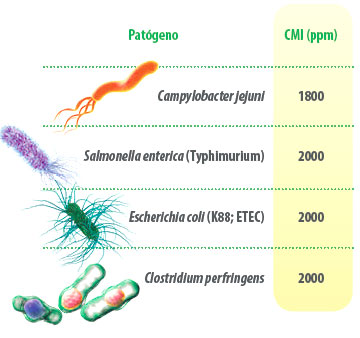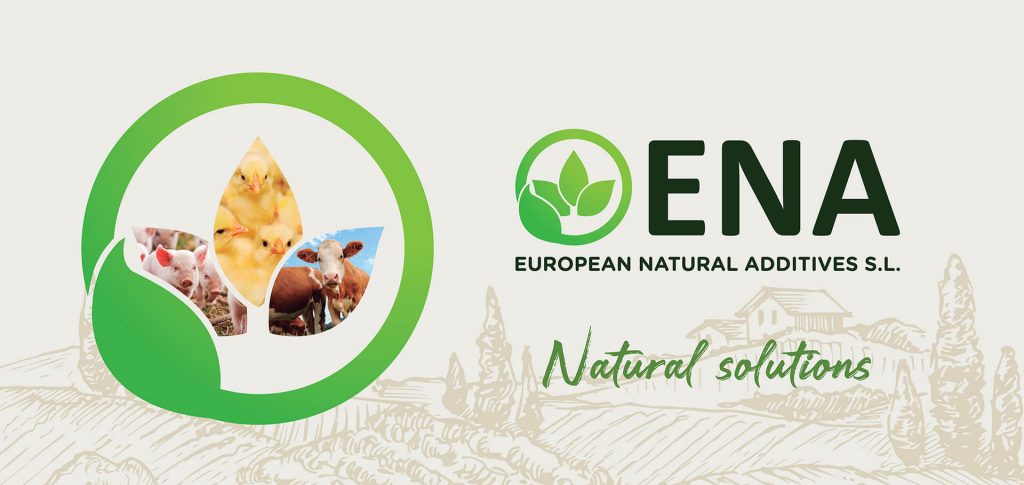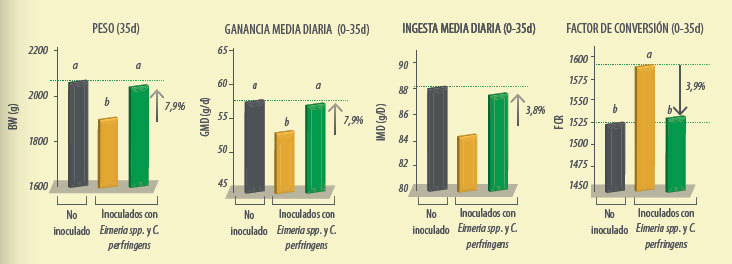Necrotic enteritis is an enterotoxemia that usually affects chickens between 2 and 5 weeks of age and can cause high mortalities, up to 50%, when it occurs acutely.
However, its subclinical form, which negatively affects nutrient absorption, worsening on average, is common:
- 12% in weight gain
- nearly 11% conversion rate
This leads to necrotic enteritis, mainly the subclinical form, causing severe economic damage inbroiler production, estimated at more than 1770 million euros per year globally (Avian Pathol. 2011; 40: 341-347; World Poult. 2000, 16: 42-43; Avian Dis. 2010: 54, 1237-1240).
The causative agent is the spore-forming Gram-positive anaerobic bacteria Clostridium perfringens, basically types A and C, capable of producing toxins (α and NetB) that induce damage in the epithelium of the small intestine (jejunum and ileum) and liver, mainly (J Appl Poult Res. 2016; 44: 359-369).
It is known that Clostridium perfringens is a ubiquitous microorganism, present even in the intestine of healthy birds. Therefore, a triggering factor is usually necessary for it to induce the lesions characteristic of necrotic enteritis.
These triggers often converge in altered gut microbiota composition or damage to the intestinal mucosa, including:
- coccidiosis – especially Eimeria acervulina and Eimeria maxima-.
- mycotoxicosis
- salmonellosis
- ascaridiosis
- elevated levels of certain ingredients in the diet, factors that promote slowed intestinal transit or bacterial overgrowth, among others (Anim Nutr. 2015; 1: 1-11).
Prior to its prohibition, the use of antibiotics in feed for prophylactic purposes prevented necrotic enteritis.
In fact, in countries with a ban on the use of growth-promoting antibiotics, the incidence of necrotic enteritis has increased (Anim Nutr. 2015; 1: 1-11).
Therefore, in our post-antibiotic era, other strategies must be resorted to, such as:
- improve immune response
- reduce pathogen load
- and/or use feed additives, such as certain organic acids (OAs) or plant extracts with antimicrobial effect (Anim Nutr. 2015; 1: 1-11).
Effects of the combination of short-chain organic acids and phytogenic substances against necrotic enteritis.
One of the aspects that explain the efficacy against necrotic enteritis of specific combinations of short-chain OCs with phytogenic substances (SF) is the antimicrobial effect they exert on Clostridium perfringens, among other pathogenic bacteria (Table 1).

This is because the bacterial wall composition consists of 90-95% peptidoglycans, which allows the passage into the cellular interior of hydrophobic molecules, such as non-dissociated forms of AO and certain SF (Pathogens. 2015; 4: 137-56).The combination of AO + SF exhibits broad-spectrum antimicrobial efficacy, effective against Gram-positive bacteria such as Clostridium perfringens, the causative agent of necrotic enteritis in chickens.
Method of antimicrobial action of OCs and FSs
Non-dissociated forms of the AO (Advances in Pork Production. 2005; 16: 169). can:
- penetrate the bacterial wall
- destructuring the cytoplasmic membrane
- and dissociate inside it, reducing the pH
- and, together with the anion generated, alter metabolic functions, leading to the death of the bacteria.
In the case of phytogenic (SF) molecules, the antimicrobial effects would be caused (Pharm. 2013, 6: 1451-1474) by:
- damage to the bacterial membrane,
- the inhibition of enzymes of the bacterial energy metabolism
- denaturation of certain proteins
|
The antimicrobial effects of OCs begin in the feed itself and then predominate in the animal’s crop, proventriculus and gizzard.
In contrast, in the case of SFs, these persist in later sections of the gastrointestinal tract, which seems to contribute to the benefits of the AO+SF combination (Anim Prod Sci. 2017; 57: 821-827).

Other positive effects of OCs and SF
In addition to this antimicrobial efficacy against Clostridium perfringens, both OCs and SFs can produce positive effects on factors that contribute to the occurrence of necrotic enteritis or its consequences.
Phytogenic substances (SF) … In addition they can:
- Preserve and stimulate the absorption function of the gastrointestinal tract.
- Improve epithelial morphology, increasing the length of intestinal villi and, therefore, the absorption surface.
- Increasing the secretion of endogenous digestive enzymes.
- Regulating the intestinal microbiota
- Modulate immune responses (by regulating the expression of proinflammatory markers).
- Antioxidant effects
- and even, as in the case of cinnamaldehyde, act against Eimeria (Anim Prod Sci. 2017; 57: 821-827; Vet. Parasitol. 2011, 181: 97-105).
Organic acids (AO) … In addition, as described in Advances in Pork Production. 2005; 16: 169, they can stimulate:
- the development of the gastrointestinal mucosa
- epithelial growth, absorptive capacity, epithelial growth, absorptive capacity, and
- and electrolyte transport (greater absorption of ions and water), helping to prevent diarrhea, among other effects.
Experimental test of AO-SF combinations
These multi-day effects of specific AO-SF combinations would explain the improvements in productive parameters obtained with AO + SF combination* in the trial carried out at IRTA(Institut de Recerca i Tecnologia Agroalimentàries. Tarragona, Spain).
- Test animals: 372 male Ross 308 chickens (12 chickens/pen), fed a diet based on wheat, barley and soybean.
- Treatments:
Distributed in the following treatments (10-11 replicates/treatment) depending on whether they were experimentally infected with Eimeria spp. and Clostridium perfringens, as a model of necrotic enteritis:

Inoculated animals were administered live attenuated oocysts of Eimeria acervulina, E. maxima, E. mitis and E. tenella on day 9.
On days 15, 16 and 17, inocula of107 -108 CFU of C. perfringens obtained from farms affected by necrotic enteritis were administered.
- Duration: 35 days
- Parameters assessed: productive parameters and mortality were evaluated.
Results
The inclusion of the combination* of AO + SF at 2.5 kg/t feed significantly improved live weight, average daily gain, average daily intake and feed conversion (days 0-35) compared to the inoculated control group, restoring the parameters and mortality to normal levels (fig. 1 and 2; table 2).



|
Conclusions:
|
The combination* of AO + SF tested in this paper was ENASSENCE





